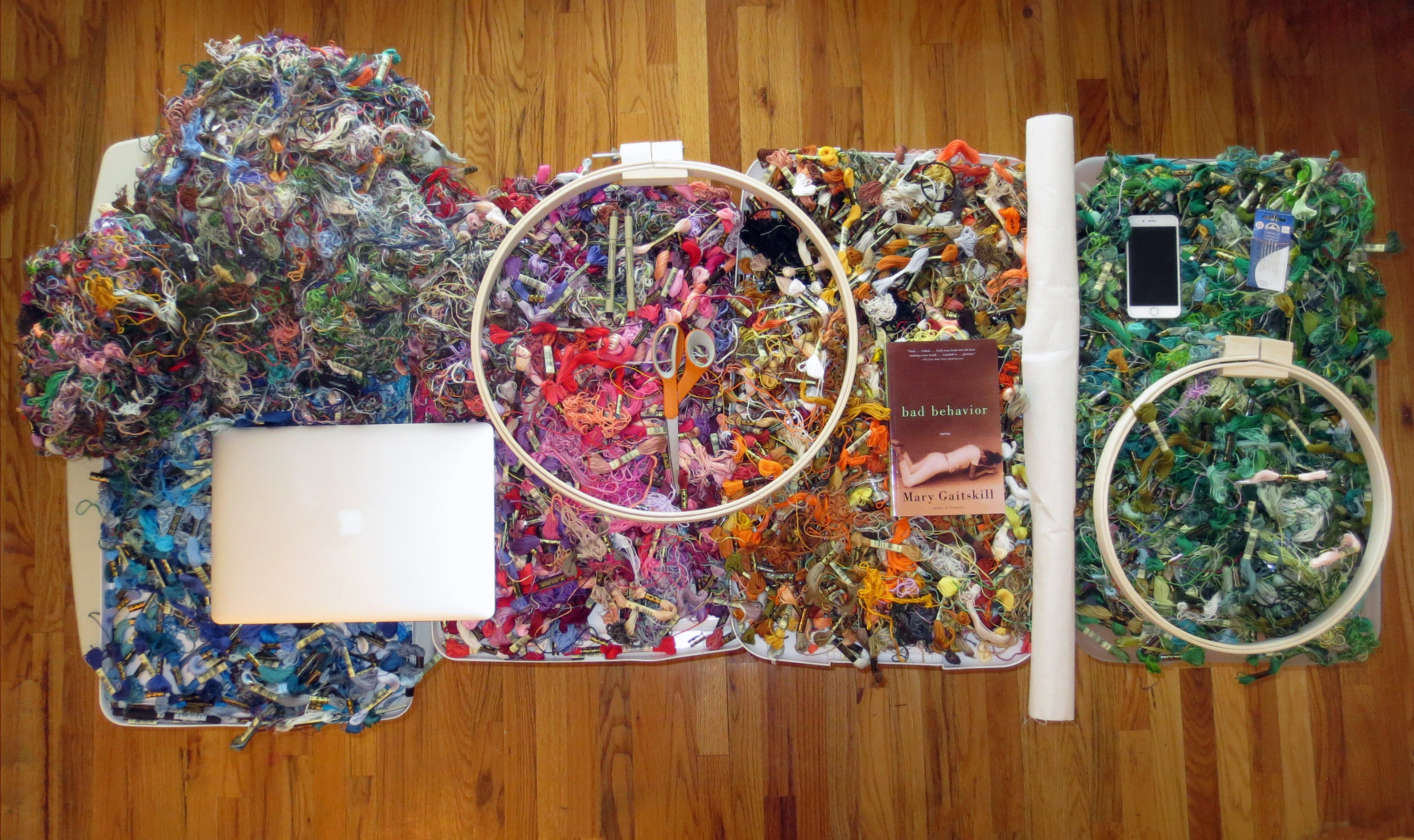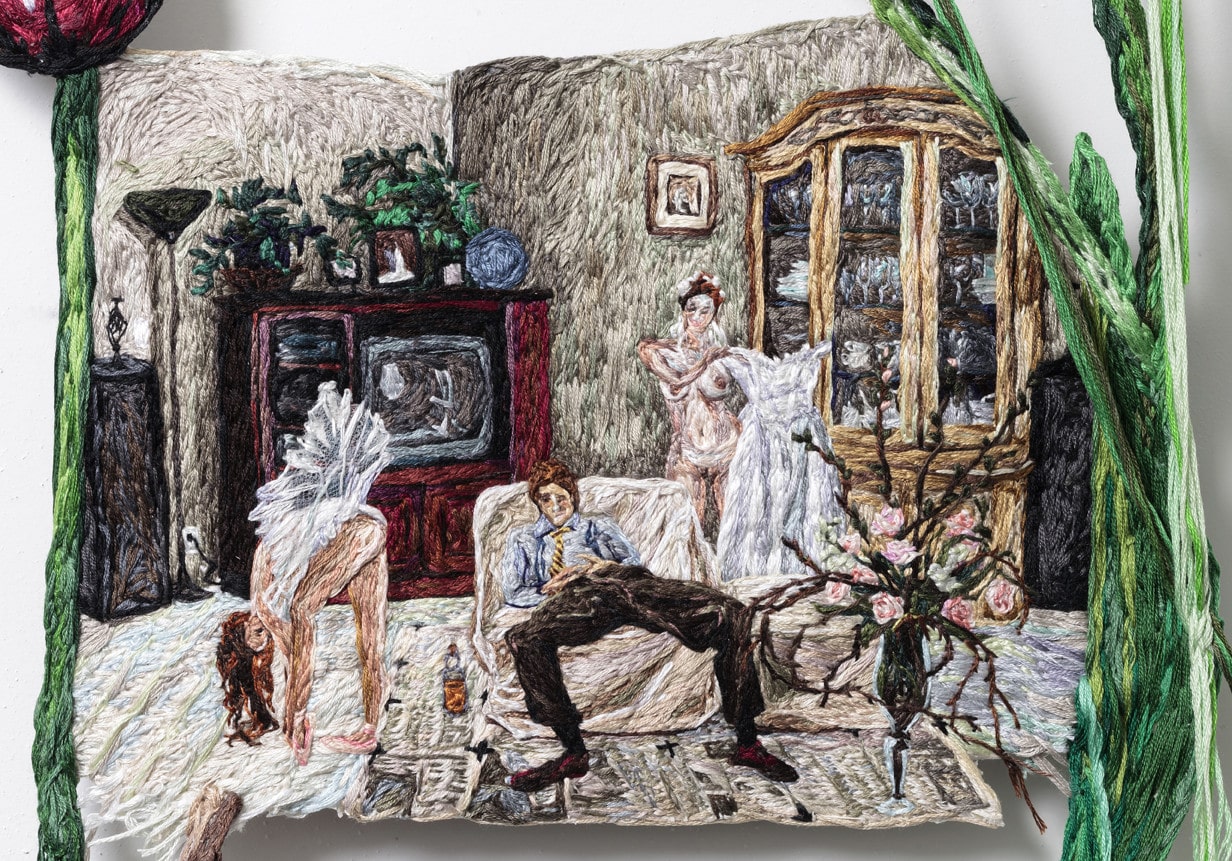
I am interested in the way that embroidery can physicality sublimate the emotional content of a narrative.
- My computer (specifically for Photoshop, the internet for source images, and TV/music/podcasts to listen to)
- My phone (to take photos for source images)
- Thread
- Needles
- Scissors
- Markers
- Fabric
- Embroidery Hoop(s)
- Good Fiction
Who are you and what do you do?
I make embroideries that tell stories about desire. The narratives are reactions to my experiences, fantasies, and fiction that has resonated with me.
After forming the initial narrative I build Photoshop collages to use as reference images to embroider from. I use images I find online, screenshots, and sometimes photos I’ve taken.
During this phase the initial narrative evolves based on the images I gather, often to connect to larger social situations or ideas. My current project is about a group of people trying to find love, self understanding, and fun through adult games.
I’m thinking about emotional and sexual interactions as escapism, self actualization, and disaster. The events of the story occur in proximity to a suburban cul de sac. There is a broken labyrinth in a backyard, several basements which have been finished to dictate specific types of play or dress up, and some exchanges at a local bank. I’ll be showing the entire project at Freight + Volume this September.
You draw a lot of inspiration from pop culture, and social media sites like Tumblr. Do you intentionally stick to modern topics to try and change how people view a traditional medium like embroidery?
I came to embroidery for material reasons, rather than as an effort to change the way that embroidery was viewed.
Before that I had been a painter, driven by images and narratives. The switch to embroidery occurred by chance. I had some embroidery thread in the studio that I was experimenting with for some sculptures, and one day I happened to try to make a small drawing in thread.
I was immediately excited about the ways it physically transformed both my experience of image making and the resulting work. I am interested in the way that embroidery can physically sublimate the emotional content of a narrative, especially as it devolves into abstraction in certain spaces, as much as it can simultaneously be an image that depicts content.
Of course paint can do this too, but I never really had the personal connection to paint that I do with embroidery.
In terms of images, I use what feels natural. Images from Tumblr, or other internet sources and figures from pop culture, feel like the most honest language I have with which to illustrate my narratives.
These images also make up the visual landscape (my life/my experience of media) in which the original experiences or fantasies that inspired the narratives occurred, which is probably a large part of why they feel like the right vocabulary to tell the stories in.
I try to work in an uninhibited way. The initial process is driven by emotional impulses. As I finalize the collages and sew I think about the images I’m using, and the greater implications of the narrative.
I make embroideries that tell stories about desire. The narratives are reactions to my experiences, fantasies, and fiction that has resonated with me.
Your work features a lot of nudity, and potentially graphic images. Do you think by stitching things like soft core porn in thread it changes how people react to them?
Yes, definitely. Embroidery removes a level of photographic truth and specificity, so images probably become less provocative or threatening in thread. But I don’t consider any of the initial reference images that I work with to be intrinsically shocking.
I’m not interested in embroidering these images for the reason that it might seem like the history of embroidery puts it at odds with eroticism, and that it might be some kind of joke or transgression to collide the two. My ultimate motivation is to make images I need to see, and to describe specific fantasies, fears, and confusing interactions between people, and explicit imagery is a part of this.
Stitching the images imbues them with another type of intensity, which comes from the time and commitment required to render them in thread. Hopefully the embroidered images trade the direct sexual experience of the original source images for a tactile presence and a narrative context, and thereby a new kind of eroticism.

Sophia Narrett’s Portfolio











